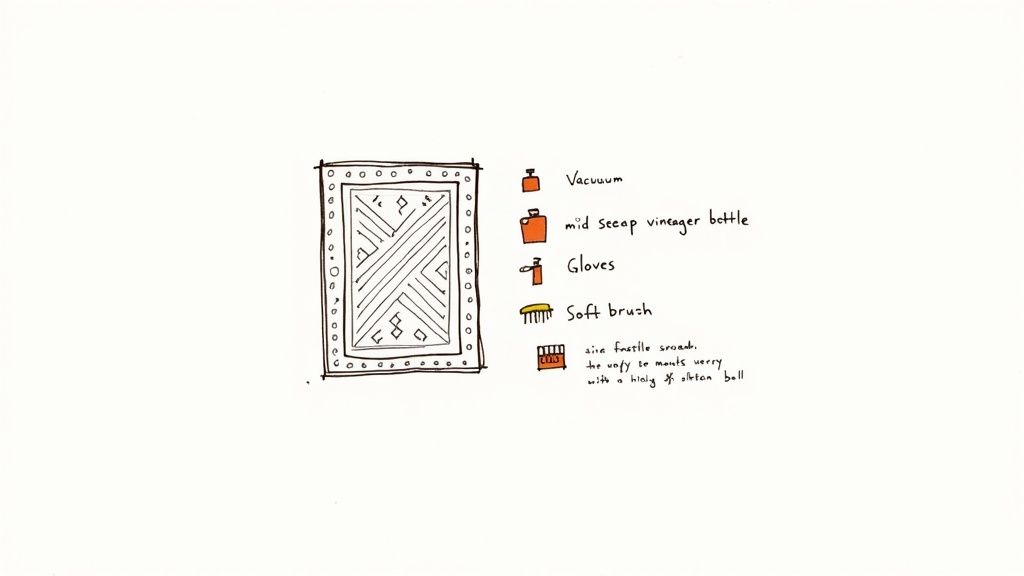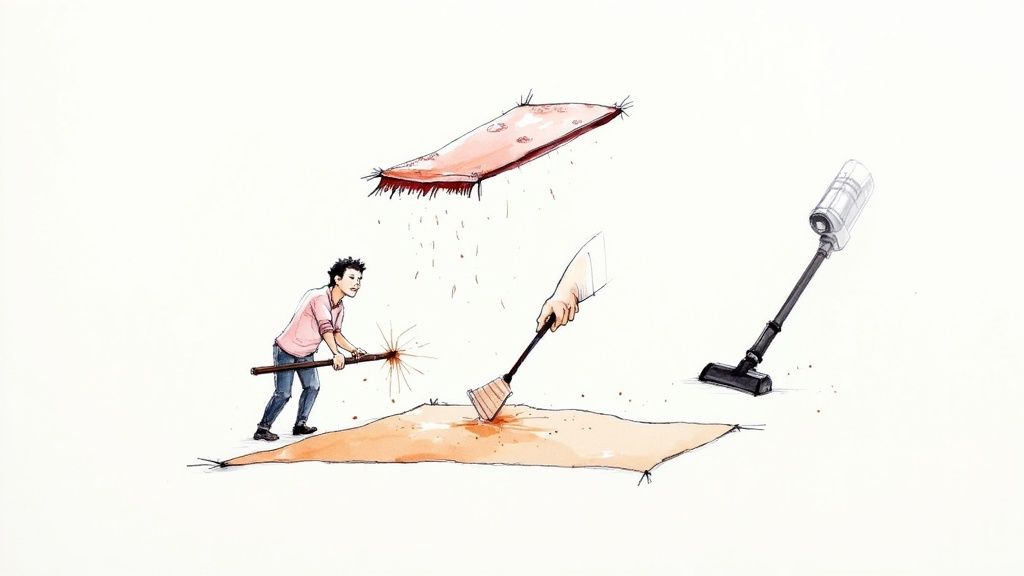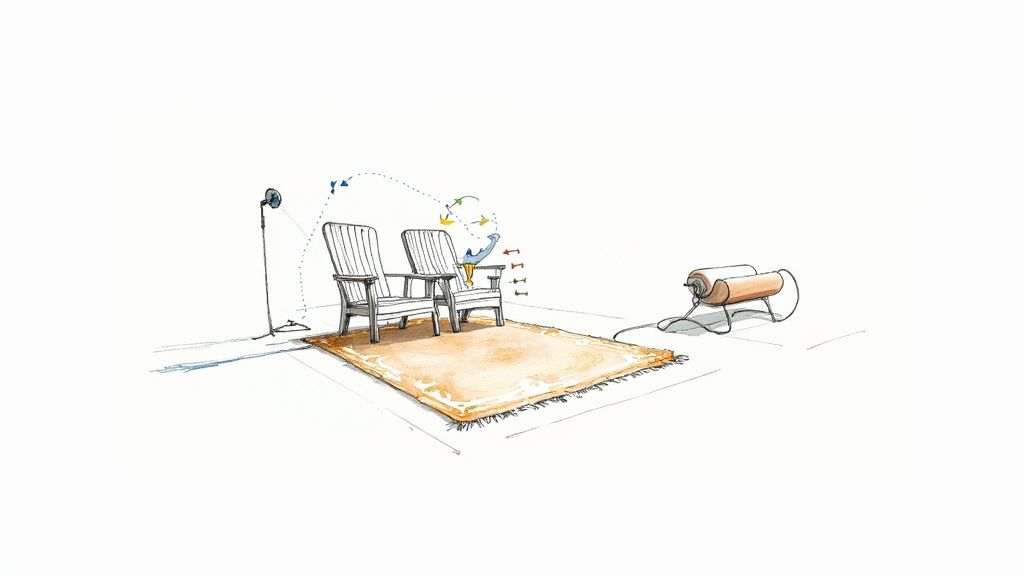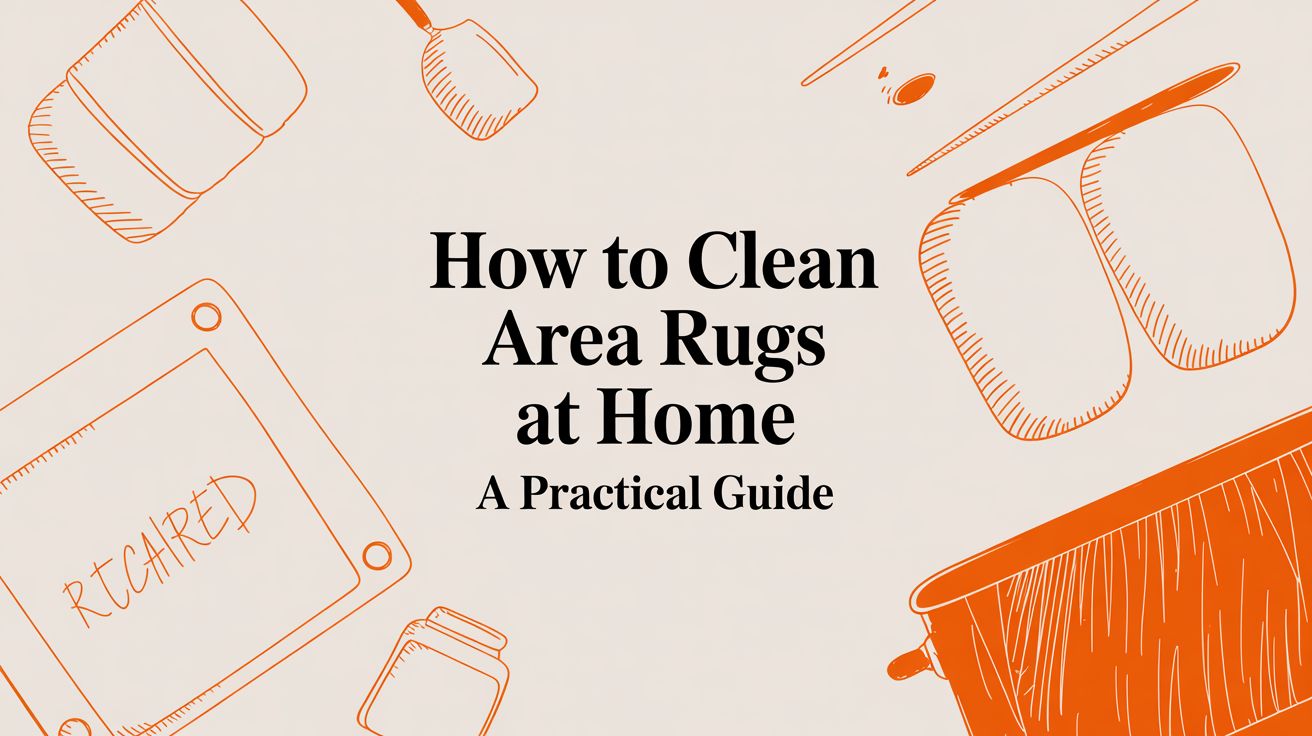Before you even think about scrubbing or soaking your rug, you need a game plan. Seriously. This is the part everyone wants to skip, but it’s the difference between a beautifully refreshed rug and a faded, shrunken mess.
Just a few minutes of prep work—figuring out what your rug is made of, grabbing the right stuff, and doing a quick color test—can save you a world of hurt.
Your Pre-Cleaning Checklist for Any Area Rug

Jumping in blind is a huge gamble. You wouldn't throw a wool sweater in a hot wash, right? The same logic applies here. What works for a tough synthetic rug could absolutely destroy a delicate silk one.
It’s no surprise that people are paying more attention to keeping their homes clean and healthy. In 2022, the global market for carpet and upholstery cleaning hit about $55 billion. People want to protect their investments and keep allergens down, and that all starts with doing things the right way.
H3: First, Figure Out Your Rug's Material
Flip your rug over and look for a tag. This is your cheat sheet. It will tell you the fiber content—wool, cotton, jute, silk, or a synthetic like polypropylene.
- Natural Fibers (Wool, Silk, Cotton): Think delicate. These guys are sensitive to harsh chemicals and high heat, so you'll need to use gentle, pH-neutral cleaners.
- Synthetic Fibers (Polypropylene, Nylon, Polyester): These are the workhorses. They're built to be more durable and stain-resistant, so you have more cleaning options.
- Plant-Based Fibers (Jute, Sisal, Seagrass): These rugs hate water. They soak it up like a sponge and can stain easily, so a low-moisture approach is a must.
No tag? No problem. You can usually tell by touch. Wool feels soft and springs back. Synthetics can have a slightly plastic-y feel. Jute is rough and fibrous. Knowing this is the foundation for everything that comes next.
To make it even easier, here's a quick reference guide I put together for my clients.
Rug Material Cleaning Cheat Sheet
This table breaks down the best approach for the most common rug types you'll find. Always test a small spot first, but this will get you pointed in the right direction.
| Rug Material | Recommended Cleaning Method | Solutions to Avoid |
|---|---|---|
| Wool | Gentle, pH-neutral soap and cold water. Blot, don't scrub. | Hot water, alkaline detergents (like ammonia), bleach. |
| Cotton | Machine washable (if small) or gentle handwashing. | Harsh chemical cleaners, vigorous scrubbing that can stretch fibers. |
| Silk | Professional cleaning is best. If DIY, use cold water and a silk-specific cleaner. Blot only. | Any heat, enzymes, acids, or alkaline cleaners. Very delicate. |
| Synthetics | Most commercial carpet cleaners are safe. Can handle gentle scrubbing. | Strong solvents like acetone, which can melt the fibers. |
| Jute/Sisal | Dry cleaning methods are ideal. Minimal water. Blot spills immediately. | Soaking with water, steam cleaning, soap-based cleaners. |
Remember, when in doubt, call a pro. It's cheaper than buying a new rug.
H3: Gather Your Cleaning Tools
Good news—you probably already have most of what you need. Don't run out and buy a bunch of fancy products just yet.
Here's your basic kit:
- A vacuum with different attachments (especially the upholstery one)
- A few clean, light-colored microfiber cloths
- A bucket or an empty spray bottle
- A soft-bristled brush (an old toothbrush works for small spots)
- Plain white vinegar and a mild dish soap
Pro Tip: Never, ever use a colored towel or cloth to clean your rug. The dye can bleed right onto the fibers, especially when wet, leaving you with a brand-new stain. Stick with white cloths only.
H3: The Make-or-Break Colorfastness Test
Don't skip this. I'm serious. This one tiny step will tell you if your rug's beautiful colors are about to become a blurry, muddy disaster.
Mix up a tiny bit of your cleaning solution. Find a hidden spot on the rug—a corner that's usually under the couch is perfect. Dab a small amount of the cleaner on it.
Wait a minute, then press a clean white cloth firmly onto the spot. Check the cloth. Did any color come off? If you see even a hint of dye, your rug is not colorfast. Your only safe options are to use plain water for cleaning or call in a professional. For sensitive rugs, looking into https://citruscarpetcleaningatlanta.com/organic-carpet-cleaners/ is a great idea for a gentler approach.
And while you're in cleaning mode, it never hurts to have a solid plan for the whole house. You might find some useful tips in a comprehensive vacation rental cleaning checklist that can apply to general home maintenance.
Getting Out the Loose Dirt and Hidden Grime

Before you even think about mixing up a cleaning solution, the first real job is getting all the dry soil out. This is a non-negotiable first step.
So many people make the mistake of skipping this part, but as soon as water hits that hidden dust, you’ve just made mud. Trust me, it makes the whole process ten times harder.
A quick pass with the vacuum is a start, but it’s nowhere near enough to get the grit that’s been ground deep into the fibers over time. The surface dirt is just what you can see; the real problem is everything that's worked its way down to the rug's backing.
Go Beyond a Simple Surface Vacuum
To really get your rug clean, you have to think in reverse. Flip the whole thing over and start by vacuuming the backing.
Set your vacuum to its lowest setting and use the beater bar. Go over the entire backside slowly and methodically. This vibration is like a mini earthquake for your rug, shaking all that deeply embedded dirt loose and forcing it to fall out onto the floor.
Once you’ve vacuumed the back, carefully roll up the rug. You'll probably be shocked at the pile of sand and grit on the floor. Clean that up, unroll the rug right-side-up, and then vacuum the top surface like you normally would. Now you're actually getting all the gunk that you just dislodged.
A Quick Note on Delicate Rugs: If you have a high-pile shag, a delicate silk, or an antique rug, that aggressive beater bar can do more harm than good. For these types, it's much safer to take them outside and beat them the old-fashioned way. Just drape it over a sturdy clothesline or deck railing and use a broom handle to give the back a few good whacks. Gravity will take care of the rest.
Tackling Stubborn Pet Hair
If you have pets, you know that their hair has a special talent for weaving itself into rug fibers where even the best vacuums can't grab it.
Before you even plug in the vacuum, grab a simple rubber window squeegee. It works like magic.
Just drag the rubber edge of the squeegee across the rug in short, firm pulls. You’ll see pet hair, and even human hair, bunch up into clumps that you can just pick up and throw away. This little trick does in a couple of minutes what your vacuum might struggle with for ages. Getting the hair out first lets the vacuum focus on the fine dust and dander. It’s a total game-changer for pet owners.
Tackling Spills and Stains Like a Pro
It's going to happen. No matter how careful you are, spills are just a part of life. A tipped glass of wine during movie night or a coffee that misses the coaster doesn't have to mean disaster for your beautiful area rug. The real secret is acting fast—and acting smart.
The first rule of stain club is simple: blot, never rub. I can't stress this enough. Grinding a fresh spill into the rug with a scrubbing motion pushes it deeper into the fibers. It can even damage the texture permanently, causing ugly fraying. Instead, grab a clean, dry, white cloth (so no color transfers), and press down firmly to soak up as much as you can.
Your Go-To DIY Stain Solutions
For a lot of common household spills, you probably don't need a heavy-duty chemical cleaner. Some of the best tools are already hiding in your pantry.
- Club Soda for Red Wine: The bubbles in club soda are surprisingly great at lifting a fresh wine stain. Just dampen a cloth with it and blot gently until you see the stain disappear.
- Vinegar and Water for Coffee: This is a classic for a reason. Mix up a 50/50 solution of white vinegar and cold water in a spray bottle. Give the coffee stain a light mist, let it sit for a couple of minutes, then start blotting it away.
- Baking Soda Paste for Grease: Oily food stains can be tricky. My first move is to sprinkle a generous amount of cornstarch or baking soda on the spot. Let it hang out for about an hour to pull the grease out, then vacuum it all up. If there's any color left behind, a little mild soap solution will usually take care of it.
The Right Technique for Stain Removal
How you clean is just as important as what you clean with. Always, always work from the outside of the stain in toward the center. It's a simple trick, but it stops you from accidentally spreading the stain and making a small spot a much bigger headache.
Once you've treated a stain, I always recommend "rinsing" the area. Just blot it a few times with a clean cloth dampened with plain water. This gets rid of any leftover cleaning solution that might become a dirt magnet down the line.
A critical mistake people make is using way too much liquid. Drenching the spot can seep through and damage the rug's backing, or even the floor underneath. Use minimal moisture and blot, blot, blot.
Dealing with Tougher Pet Accidents
Pet owners know that pet messes are a whole different ballgame. Standard cleaners just can't handle the odor-causing bacteria left behind. This is when you need to bring out the specialized products. For pet owners, learning a few specific methods, like how to clean up dog pee on carpet, is a real game-changer.
These situations call for something with more power. This is exactly why it's so helpful to understand what is an enzymatic cleaner. These cleaners are designed with special enzymes that literally break down and digest the proteins in pet urine. They don't just cover up the smell; they eliminate the source completely.
This trend of handling more cleaning at home is getting bigger. In 2023, the global carpet cleaner market was already valued at USD 1.13 billion, and it's expected to keep growing. People want more control over their rug care, and the market is responding with everything from handheld spot cleaners to bigger machines that empower you to tackle these issues yourself.
How to Deep Clean Your Entire Rug
Sometimes, vacuuming and spot treatments just don't cut it. When your whole area rug is looking a little tired from foot traffic, pets, or just life in general, a full deep clean can work wonders. And believe it or not, you can absolutely tackle this at home with the right game plan.
It's no surprise that homeowners want cleaner, longer-lasting rugs. The professional area rug cleaning market was valued at USD 1.2 billion in 2024 and is projected to hit USD 1.8 billion by 2033. People are investing in their homes, whether that means calling a pro or rolling up their sleeves and doing it themselves.
The Manual Hand-Washing Method
Got a smaller, more delicate rug? Maybe a vintage wool runner or a family heirloom? Hand washing is definitely your safest option. This gentle approach gives you total control, so you don't have to worry about a machine's harsh agitation damaging fragile fibers or making colors bleed.
The best place to do this is outside on a clean tarp or patio, preferably on a warm, sunny day to help with drying.
Just mix a few drops of mild dish soap into a bucket of cool water. That's it. Using a soft-bristled brush, gently work the suds into the rug's fibers, always moving in the direction of the nap. Go section by section to avoid soaking the rug, which can mess up the backing and make it take forever to dry.
Not sure where to start with a specific spill? This quick guide can point you in the right direction.

As you can see, what you do in those first few moments really depends on what you’ve spilled.
Using a Carpet Cleaning Machine
If you're dealing with a larger, more durable synthetic rug, renting a carpet cleaning machine is a massive time-saver. These machines are great because they spray a cleaning solution deep into the fibers and then immediately suck all the dirty water back out, pulling up grime that hand washing could never reach.
Before you start, give the rug a really thorough vacuuming to get rid of all the loose dirt and debris. When you're ready to clean, only use the recommended amount of cleaning solution. Overdoing it with the soap will leave a sticky residue that ends up attracting even more dirt later on.
Crucial Tip: Let the machine do the work. Use slow, overlapping passes and don't push down hard. After you've gone over the rug with the cleaning solution, it's a good idea to do a "rinse" pass with just plain water in the tank to pull out any leftover soap.
DIY vs Machine Cleaning Comparison
Deciding between washing by hand and renting a machine really comes down to your rug's type, size, and how much time you have. Here’s a quick breakdown to help you choose the best route.
| Factor | Manual Hand-Washing | Carpet Cleaning Machine |
|---|---|---|
| Best For | Delicate, vintage, or small natural fiber rugs (wool, silk, cotton) | Large, durable synthetic rugs (nylon, polyester, olefin) |
| Gentleness | Very gentle, full control over pressure and saturation | Can be harsh; risk of over-wetting or fiber damage if used improperly |
| Effectiveness | Good for surface-level cleaning and sensitive materials | Excellent for deep-seated dirt, grime, and heavy soiling |
| Effort & Time | Labor-intensive and time-consuming, especially for larger rugs | Fast and efficient, significantly reduces physical effort |
| Drying Time | Generally faster due to less water usage | Slower; powerful extraction helps, but proper airflow is critical |
| Cost | Very low (just soap and water) | Moderate (rental fees plus cost of cleaning solution) |
Ultimately, both methods work well when matched with the right kind of rug. The machine gives you that deep, restorative clean, while hand-washing provides the gentle touch needed for more precious pieces.
Keep in mind that this method uses a lot more water than washing by hand, so getting it completely dry is non-negotiable if you want to avoid mold and mildew. Patience and good airflow are your best friends here. If you're curious about techniques that use less water, you might want to look into the benefits of dry carpet cleaning methods for certain situations.
The Critical Art of Rinsing and Drying

You've done the hard part—all that scrubbing and deep cleaning—but don't pop the champagne just yet. The final steps, rinsing and drying, are exactly where a great DIY rug cleaning can go south. If you rush this stage, you're setting yourself up for stiff, soap-filled fibers or, even worse, the dreaded mildew smell.
Getting the rinse right isn't about just soaking the rug again. It's about methodically flushing out every single trace of that cleaning solution. Any soap residue left behind is a dirt magnet, plain and simple, which means your clean rug will get dirty again in record time.
Flushing Out the Cleaning Solution
If you're lucky enough to be cleaning outdoors, your best friend is a garden hose on a gentle setting. Prop the rug up on a clean patio chair or even a sloped driveway and rinse from the top down. Gravity will do most of the work, pulling the soapy water out. You're done when the water running off the bottom is completely clear and suds-free.
Working indoors? This part requires a bit more elbow grease. Grab a bucket of clean water and a sponge or cloth. You'll need to go over the entire rug, blotting with the clean, damp sponge to essentially "rinse" the fibers. Just be sure to change your water constantly—otherwise, you're just spreading dirty water around.
Removing Excess Water the Right Way
After a good rinse, your rug will be incredibly heavy with water. Whatever you do, do not twist or wring it out. This is the quickest way to permanently stretch, warp, and destroy the rug's backing and fibers, ruining its shape for good.
Instead, you need to press the water out. If the rug is a manageable size, roll it up tightly like a sleeping bag and just press down on the roll with your body weight to squeeze out as much water as possible. For a more effective method, grab a floor squeegee. Lay the rug flat and, always moving in the direction of the nap, pull the squeegee across the surface to push the water out.
Key Takeaway: The goal here is to get the rug from sopping wet to just damp before you even think about air-drying. This one step can shave hours off your total drying time.
Setting Up for a Successful Dry
Airflow is everything. A damp rug is the perfect breeding ground for mold and mildew, so getting it bone-dry as quickly as you can is what separates a successful cleaning from a disaster.
Here’s what your drying setup needs to accomplish:
- Elevate the Rug: Never, ever leave a wet rug lying flat on the floor. It needs air hitting it from all sides. Drape it over a sturdy clothesline, a few patio chairs, or even a couple of sawhorses.
- Get the Air Moving: If you're drying inside, open the windows and point some fans to blow air across the rug's surface, not directly at it. This creates a current that wicks moisture away much more effectively.
- Flip It: To make sure it dries evenly, you've got to flip the rug over every few hours. The backing almost always holds onto moisture longer than the pile, so both sides need their fair share of airtime.
Patience is a virtue here, and it's not optional. Depending on how thick your rug is and the humidity in your home, it could take anywhere from 24 to 48 hours to dry completely. A properly dried rug feels soft, smells fresh, and is finally ready to go back on your floor.
Of course, even with the best guide, some questions always come up when you're staring down a dirty rug. Let's tackle some of the most common ones I hear from homeowners.
How Often Should I Really Deep Clean My Rug?
For a rug in a busy spot like the living room or main hallway, a deep clean every 12-18 months is a pretty solid benchmark. That’s especially true if you’ve got kids or pets in the mix, because, let's be honest, they add a whole other level of wear and tear.
On the other hand, that rug in the guest room that only sees occasional foot traffic might be perfectly fine for 2-3 years between deep cleans. The real secret is what you do in between—good, regular vacuuming and jumping on spills the moment they happen will buy you a lot more time.
Here's a Pro Tip: Your rug will tell you when it's ready. Forget the calendar for a second. If it starts looking a bit dingy or feels stiff or even slightly sticky to the touch, it's time for a wash, no matter how long it's been.
Can I Just Hit It With a Pressure Washer?
I get it, it sounds like a fantastic shortcut. But for almost any indoor area rug, this is a hard "no." That high-pressure blast of water is way too aggressive for rug fibers, and it's absolute kryptonite for natural materials like wool or silk.
Going the pressure washer route can cause a world of hurt:
- Fiber Damage: You can easily shred, fuzz, or straight-up tear the rug's delicate fibers.
- Color Bleeding: The force will make the dyes run together, turning your beautiful pattern into a blurry, faded mess.
- Backing Damage: It can completely disintegrate the latex and glue holding your rug together from the back.
The only time you might even consider this is on a super-tough, synthetic outdoor rug, and even then, you’d need to use the absolute lowest pressure setting possible. For any indoor rug you care about, the risk is just not worth it.
What's the Best Way to Get Rid of Pet Odors?
When you're fighting pet smells, you've got two main weapons, and they're used for different battles. For that general, lingering "eau de dog" on a dry rug, baking soda is your best friend.
Just sprinkle a very generous amount all over the rug, use a soft brush to work it in a little, and let it hang out for a few hours—or even overnight if you can. The baking soda is great at absorbing those smelly molecules. Afterward, just give it a very thorough vacuuming.
Now, for specific pet urine spots, you need to bring in the big guns. An enzymatic cleaner is the only real solution here. These cleaners don't just cover up the smell; they contain special enzymes that actually break down the uric acid in the urine, completely eliminating the source of the odor.
Is It Safe to Clean an Antique Rug Myself?
If you have a valuable antique, a hand-knotted treasure, or a classic Oriental rug, trying to clean it at home is playing with fire. These rugs are often made with incredibly delicate natural fibers and colored with old-school vegetable dyes that are notorious for running.
Even the gentlest household cleaners and DIY methods can cause permanent damage, from colors bleeding everywhere to weakening the actual structure of the rug. For pieces like these, the only smart move is to call in a professional rug cleaning specialist who knows how to handle fragile, high-value textiles.
Don't let a dirty rug drag down the vibe of your home. If you decide you'd rather leave the deep cleaning to the experts, Citrus Carpet Cleaning Buford uses a low-moisture, citrus-based cleaning process that gets your rugs fresh and clean—and dry in just a couple of hours. Get your free "EXACT-imate" today by visiting us online.

